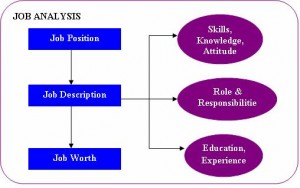The process of identifying and determining the content of a job as it relates to the activities performed and the characteristics required to perform it is called job analysis. A job analysis serves the purpose of:
- Creating job descriptions and job specifications
- Helping employees understand the content of the job, its basic duties, working conditions and the personal traits required to perform the job successfully through these job descriptions and job specifications.
- Helping the organization identify the right employees for the job based on the attributes the employee possesses compared with the requirements of the job.
It aims to answer some basic questions about the job such as why the job exists, what/how/when should the job be performed, what equipment needs to be used to carry out the job, what does the successful performance of the job look like, and so on.
Role of Job Analysis
This plays an important role in many other human resource functions in an organization such as,
- Recruitment: Job descriptions derived from comprehensive job analyses can be used in the recruitment process at various stages. The initial advertisement may be crafted based on the job analysis. Candidates may then be screened and evaluated against the criteria defined in the job description. Finally, appropriate interview questions may be created and/or tests may be devised using the job description.
- Performance Management: Job analysis allows organizations to set levels of performance for each aspect of the job as laid out in the job description. Employee performance can then be compared with expected performance and any gaps addressed through the performance management process. Supervisors who conduct performance appraisals then have a comprehensive tool at their disposal that clearly identifies for them what the job entails and what successful performance of it looks like.
- Compensation: Job analysis helps determine appropriate compensation levels for jobs by identifying skills levels required, separating out different compensable job factors, calling attention to any special working conditions, defining levels of responsibility and determining the educations qualifications, skills and experience required. In addition, job analyses of all the jobs within an organization provide a systematic method of comparing jobs across the organization to arrive at relative worth.
- Training and Development: Job analysis can be very useful in identifying training needs for individuals as well as groups based on a gap analysis of the job requirements and individual skill levels. Trainers can create training content that is tailored to the gaps. More importantly, a job analysis will allow trainers to measure the effectiveness of training by providing clear criteria for assessing whether the training has resulted in a positive change in the level of performance.
Apply for Compensation and Benefits Certification Now!!
http://www.vskills.in/certification/Certified-Compensation-and-Benefits-Manager




